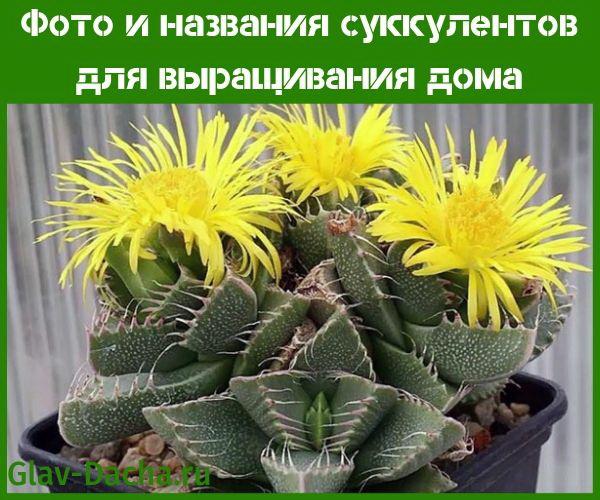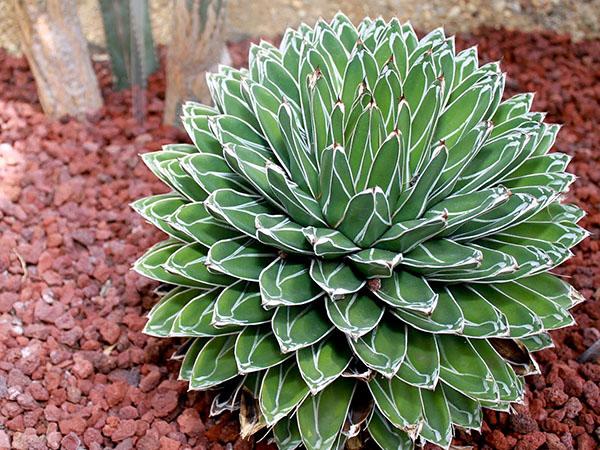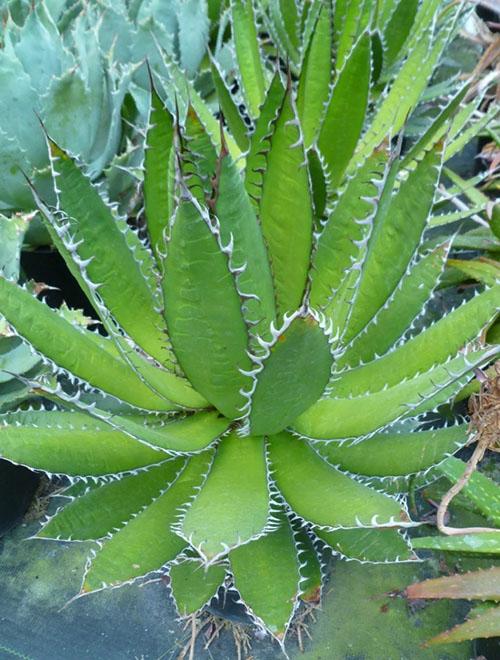Photos and names of succulents for growing at home
 Plants that nature has provided with special tissues to store water are succulents of different types. We have selected photos and names of succulents that are most often found in our homes. They do not have a common origin, and the characteristic features that have developed over time are explained by the same growing conditions. Succulents can be found in different families. For example, such as aroids, which include more than 3,000 plant species. African succulent zamioculcas also belongs to them.
Plants that nature has provided with special tissues to store water are succulents of different types. We have selected photos and names of succulents that are most often found in our homes. They do not have a common origin, and the characteristic features that have developed over time are explained by the same growing conditions. Succulents can be found in different families. For example, such as aroids, which include more than 3,000 plant species. African succulent zamioculcas also belongs to them.
The main types of succulents

Despite the general adaptation mechanisms and properties, they are very different from each other:
- Stem. Moisture is retained in plant stems, which are significantly thickened and may be ribbed. Their leaves eventually became very small or turned into thorns. Water-storing tissue is especially developed in the core of the stem and bark. Many cactuses from the American deserts and Euphorbiaceae from the African arid regions are considered to be stem succulents. Cactaceae have very diverse stems. They are very juicy, not too saturated green and completely without leaves. For protection from animals and better condensation of moisture, the stem of the plant can be covered with sharp spines or long hairs. Due to the ribbed surface, which favors a better distribution of light on the surface, transpiration - evaporation of moisture through the external organs of cacti is minimal. The rate of water consumption is generally very low, since the cell sap, which includes various sugars and organic acids, contains a gel that swells and retains water if necessary.
- Leafy. Plants store water in thick, fleshy leaves. Well-known indoor aloe and Haworthia are leafy succulents. You can see leafy succulents in the Russian Federation on dry, well-warmed sandy areas. Most often they belong to the bastard family. These are species belonging to the genera Stonecrop (Sedum) or Younger (the outdated name of the tenacious (Sempervivum)).
Succulents are plants that survive without problems in most arid areas and deserts. They have unique mechanisms that allow them to retain moisture in a large volume for a long time.
However, the juice of many plants is recognized as poisonous and therefore it is avoided to be eaten by animals and birds. The exception is safe species. Photos and names of succulents are shown below.
Such different flowers of succulents
 Succulents get the moisture they need from groundwater, dew, fog, or absorb it during rain. To make these processes more efficient and much more intense, succulents have long roots that reach the aquifer and are located almost at the surface, with the help of which the plants absorb rainwater. Thick leaves, as well as ribbed stems, fill with moisture after rain and straighten the folds. Otherwise, they would not have been able to save such an amount of liquid.
Succulents get the moisture they need from groundwater, dew, fog, or absorb it during rain. To make these processes more efficient and much more intense, succulents have long roots that reach the aquifer and are located almost at the surface, with the help of which the plants absorb rainwater. Thick leaves, as well as ribbed stems, fill with moisture after rain and straighten the folds. Otherwise, they would not have been able to save such an amount of liquid.
Succulents are undemanding. And they winter well in temperate climates. For example, plants from Canada or the Alps, as well as from the foothills of North America, are quite frost-resistant. The most common street succulents are rejuvenated ("stone rose") and sedum... They are classified as horticultural crops.
Indoor plants have excellent decorative qualities. They can be used to decorate any interior, even with insufficient lighting. These flowers grow well in a room with a low temperature, but need additional moisture. They are usually grown next to aquariums and small decorative fountains.
No need to spray the leaves; succulents need clean fresh air. In hot weather, open a window or window close to them. In winter, the air temperature should be around +10 ° C or even less.
Photos and names of succulents that you can grow yourself
Due to their rapid growth and unpretentiousness, succulents have become quite popular in home floriculture.
Agave is a spectacular decoration for large rooms
 Agave is a guest from Central America. In Russia, you can most often find American agave (Agave Americana). It is a large ornamental succulent plant, with a short thick stem and leaves collected in a rosette. Under optimal conditions, their length can reach 1.5 m or more. It blooms at the age of 6 to 15 years, produces a high arrow, 6–12 m long, on which up to 17 thousand flowers appear. This type of agave is used to decorate huge halls and halls.
Agave is a guest from Central America. In Russia, you can most often find American agave (Agave Americana). It is a large ornamental succulent plant, with a short thick stem and leaves collected in a rosette. Under optimal conditions, their length can reach 1.5 m or more. It blooms at the age of 6 to 15 years, produces a high arrow, 6–12 m long, on which up to 17 thousand flowers appear. This type of agave is used to decorate huge halls and halls.
The more compact Funka agave can be grown in an ordinary city apartment or in a private house. This plant does not take up too much space. Brown thorns grow at the ends of its gray-green leaves. At home, ropes and twines, and even wrapping paper are produced from many types of agave. And from the sweetish juice, local drinks are made - mezcal and pulque.
Home doctor-Kalanchoe
 Kalanchoe is another well-known succulent plant that many grow on windowsills. This is a representative of the fatty family. The leaves of different Kalanchoe can be sessile or with petioles, strongly or weakly dissected. When the plant blooms, an umbrella forms with white, purple, yellow, or red flowers.
Kalanchoe is another well-known succulent plant that many grow on windowsills. This is a representative of the fatty family. The leaves of different Kalanchoe can be sessile or with petioles, strongly or weakly dissected. When the plant blooms, an umbrella forms with white, purple, yellow, or red flowers.
Fat woman - money tree
 Crassula - many call this flower a fat woman. Most often, amateur flower growers grow purslane crassula, which is popularly called the "money tree".
Crassula - many call this flower a fat woman. Most often, amateur flower growers grow purslane crassula, which is popularly called the "money tree".
No need to be afraid of faucaria, she is very beautiful
 Faucaria is a strange South African plant, the leaves of which end in growths that look like the open jaws of a predator. This succulent can grow a lot. To create normal conditions, he needs to allocate a lot of space.
Faucaria is a strange South African plant, the leaves of which end in growths that look like the open jaws of a predator. This succulent can grow a lot. To create normal conditions, he needs to allocate a lot of space.
Haworthia pearl - small and compact
 Those who want to grow not such large plants should pay attention to pearl haworthia. The photo and name of the succulent is above. The type of plant is very original. And the diameter of the spherical rosette does not exceed 15 cm. The leaves of this succulent are thick, with light wart growths.
Those who want to grow not such large plants should pay attention to pearl haworthia. The photo and name of the succulent is above. The type of plant is very original. And the diameter of the spherical rosette does not exceed 15 cm. The leaves of this succulent are thick, with light wart growths.
In the photo with the names of indoor succulents, all the advantages of these plants are noticeable. Their decorative appearance and the beauty of flowers make you want to settle them at home and watch their development.